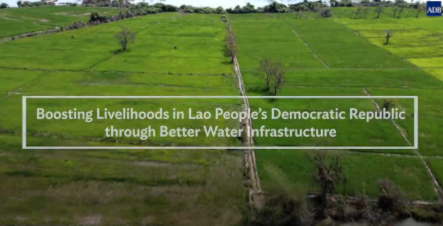

- ADB approved $36.5 million loan and grant in 2012 to support the Lao PDR to improve the country’s capacity and preparedness to manage and mitigate the impacts of flood and drought in southern Vientiane capital.
- The ADB-supported Greater Mekong Subregion Flood and Drought Risks Management and Mitigation Project helped reduce economic losses resulting from flood and drought, and improved livelihoods of 60,000 people in southern Vientiane, Lao PDR.
- The project rehabilitated flood embankment functioned as a road, water control gates, and concrete irrigation canals and provide trainings to boost agricultural productivities, incomes, and better livelihoods of farmers.
ADB approved $36.5 million loan and grant for the Lao PDR in 2012 to improve the country’s capacity and preparedness to manage and mitigate the impacts of flood and drought through the Greater Mekong Subregion Flood and Drought Risks Management and Mitigation Project in Vientiane capital and provinces of Khammouan and Savannakhet. The project helps rehabilitate flood embankment that also functions as a road spans more than 32 kilometers and has seven water control gates and stabilize agricultural production by constructing concrete canal systems as part of the pump irrigation schemes. The project also helped provide trainings on increasing agriculture productivity. This is to reduce economic losses resulting from flood and drought and improve livelihoods of the people in the project areas.
Transcript
The Mak Hiao River flows through many communities on its way to the Mekong River in southern Vientiane, the capital of the Lao People’s Democratic Republic (Lao PDR).
Water levels here fluctuate greatly, with extensive flooding in the rainy season and drought in the dry season.
This threatens agricultural productivity, economic activity, and the livelihoods of more than 60,000 people.
ADB is helping address this in the Greater Mekong Subregion including the Lao PDR, where it is providing a $36.5 million loan and grant for the country to improve water infrastructure and to help communities better manage the impact of floods and droughts in Vientiane and in the provinces of Khammouan and Savannakhet.
Excellency Dr. Phet Phomphiphak, Minister of Ministry of Agriculture and Forestry
ADB’s support for this development project is crucial. Despite the project completion, its beneficiaries have continued to support the project activities and see further achievements.
The flood embankment that also functions as a road spans more than 32 kilometers and has seven water control gates.
These structures have helped protect 20,000 hectares of agricultural land and surrounding communities from flooding.
More importantly, the project has helped stabilize agricultural production by constructing concrete canal systems as part of the pump irrigation schemes.
This system now provides enough water for irrigation in the dry season and protection from floods in the rainy season.
The project has also trained farmers through Water User Groups and demonstration gardens, and taught techniques to increase food crop yields.
Visay Chittaphone, Farmer, Dongkhuay village
What I've learned from the project's training are, firstly, dry season rice farming techniques. Secondly, vegetable farming training and then my rice production has increased. I made around 30 sacks of wet season rice, and dry season rice is around 50 to 60 sacks.
Sonomi Tanaka, Country Director, Lao PDR Resident Mission, Asian Development Bank
I am proud to say that this project is considered among the most successful ADB-financed irrigation projects in the country. Thanks to the project, dry season rice cropping was made possible.
This has pushed annual rice production 4 times higher than before the project at one project site. The risk of flooding was significantly mitigated after the flood embankment and sluice improvement.
Bountung Lathsachack, Farmer, Nalong village
In the past, we made a small amount of rice. Now we can produce a lot more than before. Our family's living condition has improved. I have kept part of my income for household spending. I also have some savings to support my children for their further education in the future.
